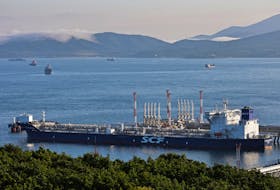News out of the Organization of Petroleum Exporting Countries (OPEC) meeting in Vienna Thursday was considered good news for the provincial coffers, with the cartel and its partners agreeing to keep their oil output suppressed through 2018.
The decision was welcomed here as support for a continued, positive trend in crude prices, even as those familiar with the industry were the first to note how quickly things can change, and
the province has to take the oil prices as they come.
After taking part in a sharing circle with Labrador Land Protectors on the Muskrat Falls hydroelectric project in Happy Valley-Goose Bay on Wednesday evening, Nalcor Oil and Gas president Jim Keating was back in St. John’s the next morning, speaking with The Telegram before the OPEC decision was announced.
RELATED STORY:
OPEC and allies likely to extend production cuts at meeting
“As I see it now and as it comes out of yesterday’s committee meetings going into this, most analysts and folks who are following this tend to believe they will get about a nine-month extension (to the production cut). If that happens, that’s going to be good for oil-producing regions like Newfoundland and Labrador. It’ll likely firm up prices,” he said.
The decision was, ultimately, to extend from March through December 2018. As reported by Reuters, the plan is to review prices in June.
“I guess what we are expecting to happen, though, is the inevitable response from U.S. shale, and at what point will the price of global oil rise to trigger a growth in U.S. rig counts and put that balance that OPEC is seeking out of kilter? That remains to be seen,” Keating said.
The better the oil price, the easier it is for shale oil producers to come online. Unlike the kind of projects producing offshore Newfoundland and Labrador, they are able to get to first oil much faster.
But Keating said operators deciding to go into production here do take the potential for price swings — whatever might drive them — into account in their decisions.
“I think what we can say for the production we have offshore is it’s fairly robust to today’s oil prices. When I look at the typical costs per barrel of production, that’s a range between $10 and $20 a barrel,” he said, making a point to note 2018 will include the first year of production from Hebron, the fourth major oil project in the province after Hibernia, White Rose and Terra Nova.
Oil industry consultant Rob Strong said significant movements in oil prices work against the exploration side as they do the long-term production side, and Newfoundland and Labrador benefits when companies bidding in offshore land sales feel some sense of relative stability in the market and potential for return on investment.
Apart from shale oil, Strong said, the province needs to be mindful of the competition from other offshore jurisdictions.
Strong has made five trips to Guyana in the last year, he said as an example, noting it’s a place with a burgeoning offshore, but without the challenges due to weather and other demands seen here.
Essentially, the province still needs to work to stay on the global radar.
“Some people out there think we’re a player. … We’re pretty insignificant in the global perspective,” Strong said.
He also noted rapid advancements in “alternate energy” — including wind and solar — shouldn’t be ignored.
“There’s new technologies chewing away at the traditional markets every day,” he said.
As mentioned with the province’s fall fiscal update and confirmed by the Department of Finance Thursday, every US$1 change in the price of oil affects provincial revenue by $7.4 million.
The U.S.-Canada exchange rate is also a consideration. Every one-cent change in the exchange rate impacts revenue by $5.3 million.
In preparing spring budgets, the province will consult with its oil price forecasters and take the latest OPEC decision into account.









